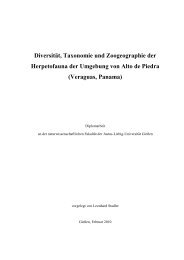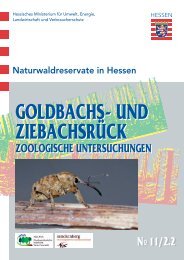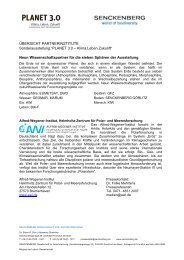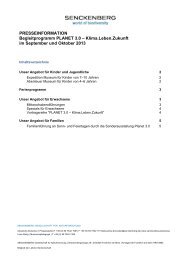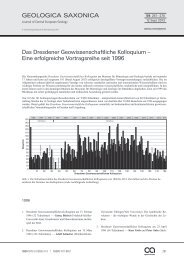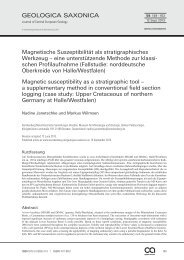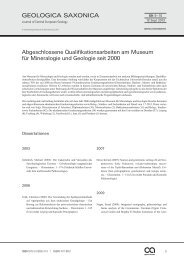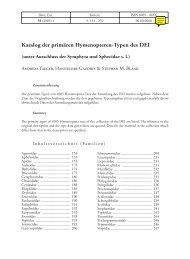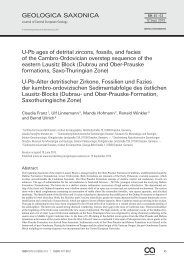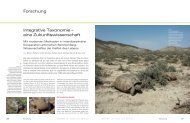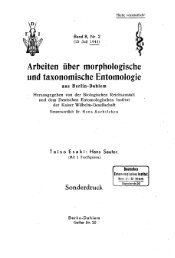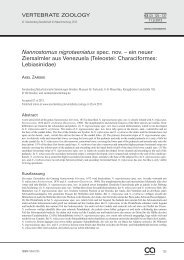Taxonomic publications: past and future - Senckenberg Museum
Taxonomic publications: past and future - Senckenberg Museum
Taxonomic publications: past and future - Senckenberg Museum
You also want an ePaper? Increase the reach of your titles
YUMPU automatically turns print PDFs into web optimized ePapers that Google loves.
Burckhardt & Mühlethaler (eds): 8 th GfBS Annual Conference Abstracts 24<br />
New phylogenies <strong>and</strong> <strong>past</strong> classifications – should we compare the two?<br />
T. Dikow<br />
Recently, many phylogenies of a diverse array of taxa have been published that<br />
are solely based on DNA-sequence data. Typically, these “new” phylogenies are<br />
compared to previously established classifications that were not necessarily<br />
derived from the rigorous methodologies of current phylogenetic systematics.<br />
These comparisons often detail the support that the “new” phylogenies give to<br />
established taxa without added insight into how such molecular studies can<br />
improve our classifications. The validity of simple comparisons of long established<br />
classifications <strong>and</strong> “new” molecular phylogenies will be discussed in light of three<br />
evident theoretical problems: (1) Can we compare the two hypotheses if both are<br />
not grounded in phylogenetic methodology? (2) Can molecular characters test<br />
morphological ones? <strong>and</strong> (3) Can new phylogenies test monophyly of taxa in<br />
previous classifications?<br />
Using a recently published molecular phylogeny of robber flies (Insecta: Diptera:<br />
Asilidae) as an example, it is shown that the common line of argumentation in<br />
molecular <strong>publications</strong> is unsound for two main reasons. First, the sheer<br />
comparison of molecular <strong>and</strong> morphological hypotheses does not entail a scientific<br />
test because morphological features used as the basis for the previous<br />
classifications are not incorporated into the molecular analysis <strong>and</strong>, therefore, the<br />
morphological characters remain as yet-to-be-tested hypotheses of homology.<br />
Second, earlier classifications may be based only on a few diagnostic features<br />
without character assessment in the Hennigian sense, <strong>and</strong> accompanying<br />
published diagrams of relationships therefore are not cladograms in a strict sense.<br />
Interpretation of <strong>past</strong> classifications should go beyond a simple comparison by<br />
underst<strong>and</strong>ing how previous classifications <strong>and</strong> diagrams of relationships were<br />
obtained, <strong>and</strong> what information they hold that can be simultaneously tested with<br />
molecular characters. Rather than simply discussing similarities <strong>and</strong> differences,<br />
modern phylogenetic studies can improve <strong>past</strong> classifications by employing (1)<br />
many character complexes (behavioural, molecular, morphological etc.); (2) broad<br />
taxon sampling (ingroup <strong>and</strong> outgroup); <strong>and</strong> (3) combined, simultaneous<br />
phylogenetic analysis of all character complexes. Modern taxonomic research<br />
projects should translate the newly obtained information into phylogenetic<br />
classifications entailing diagnoses <strong>and</strong> identification tools, which can then be used<br />
by biologists of a variety of fields <strong>and</strong> bring light to their scientific questions. This is<br />
the central role of taxonomy in the biological sciences <strong>and</strong> we are the ones who<br />
can deliver this knowledge.<br />
Org. Divers. Evol. 5, Electr. Suppl. 13 (2005)



